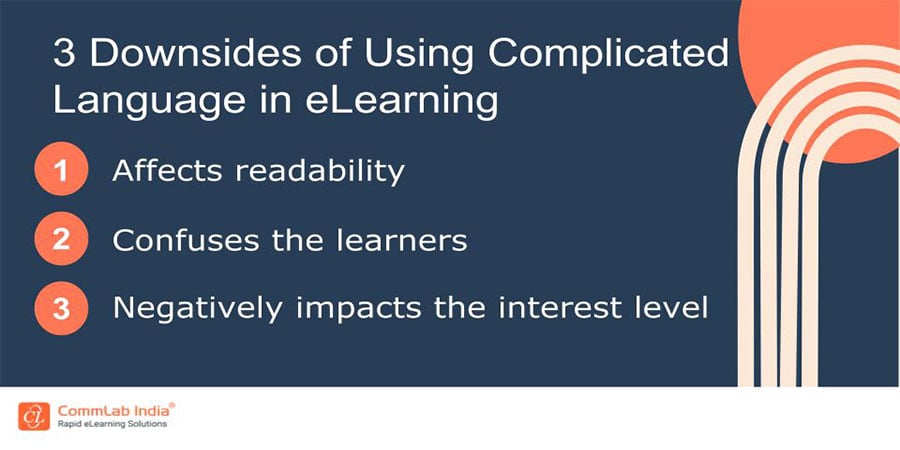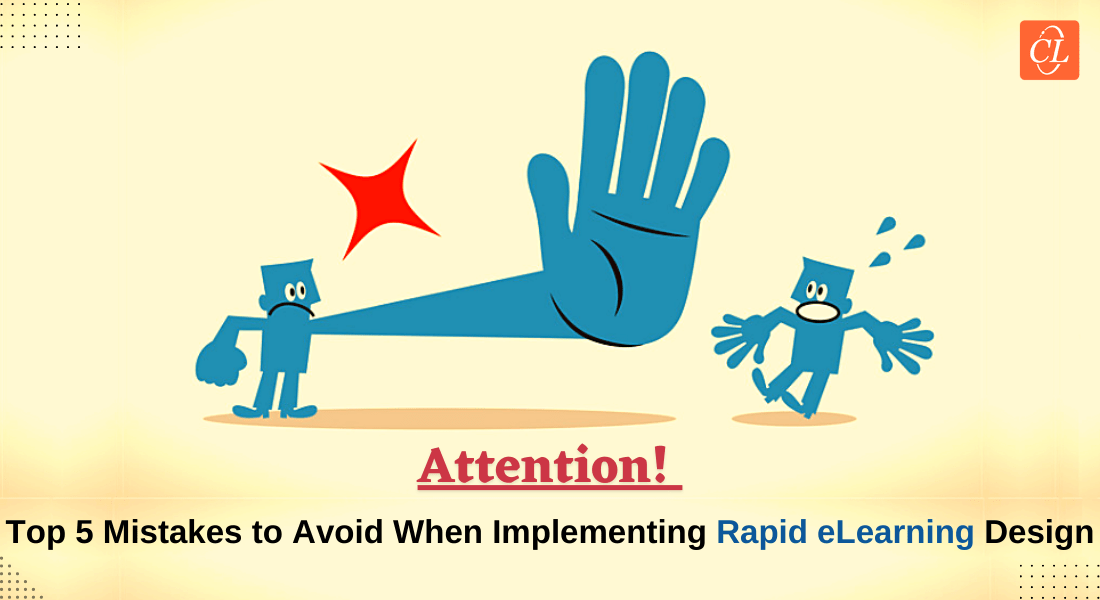5 Major Mistakes to Avoid in eLearning Design and Development

When it comes to corporate training, eLearning is a popular and effective approach. Organizations are quickly incorporating it into their training programs to meet fast-changing business needs. eLearning offers a range of other benefits such as flexibility, accessibility, self-paced learning, immersive learning experience, etc. These benefits rely heavily on eLearning design and development.
Mistakes in eLearning Design and Development Reduce Its Effectiveness
So here’s a list of 5 major mistakes you should avoid
- Not defining learning objectives clearly
- Not knowing your target audience
- Forcing employees to learn irrelevant things
- Adding too much information in one place
- Using complicated design and language
That’s right! Even a small mistake here and there can have a big impact on the effectiveness and overall outcome of the eLearning course. So it’s important to know what these mistakes are and avoid them in your eLearning design and development. In this blog, we’re going to discuss the 5 big mistakes that you should avoid in eLearning design and development.
Let’s begin!
5 Major Mistakes to Avoid in eLearning Design and Development
1. Not Defining Learning Objectives Clearly
Learning objectives set the foundation and offer direction for your course. Therefore, your learning objectives should be clear, concise, specific, and measurable so that you can evaluate whether or not they have been achieved. Along with the above elements, the learning objectives for the training course should be relevant to the audience for whom you’re creating the content.
→ Download Now: Instructional Design Guide
For example, if you’re creating an eLearning course for a sales team in a large corporation, then the learning objectives can be developing interpersonal skills, improving product knowledge, or staying updated on the current trends in the industry.
Clearly, the specification of learning objectives for an eLearning course will depend on the particular goals and needs of the organization and the target audience. However, here are some general learning objectives that you should consider while designing eLearning courses:
- Improve job-specific skills: The course should aim to help employees develop or furnish the skills they need to perform their job functions effectively. These could be technical skills, soft skills, or even a combination of both.
- Increase knowledge: The eLearning course should provide employees with relevant information about the company, industry, products, or services depending on the type of training. You can cover topics such as compliance, safety, ethics, or best practices under this category.
- Promote professional development: The course design can aim at enabling employees to improve their professional skills and competencies, such as leadership, communication, or problem-solving.
- Enhance productivity: Productivity is an important factor in measuring employee performance. Therefore, designing a course that helps employees work more efficiently and effectively to boost their productivity is a good learning objective. For example, you can design courses that train employees on using technology or process improvements.
- Support employee retention: The course should help employees in augmenting their skills and knowledge that somehow benefits them in their growth and career development. It makes them feel valued and engaged in their work, thereby improving job satisfaction and reducing employee turnover.
- Meet regulatory requirements: Keep in mind to design and develop an eLearning course that is in line with the company and industry standards. It should not leave employees in disarray or in a state of confusion.
- Foster a culture of learning: Your eLearning courses can also be based on the aim and objective of fostering continuous learning for the employees. It helps the learners stay up-to-date on information and innovation in their fields and can implement it in their work. This augments individual as well as organizational growth.
2. Not Knowing Your Target Audience
You should know who you are designing the eLearning course for. It allows you to plan and structure the eLearning design and development strategy accordingly. From the instructional design model to the activities you’ll incorporate in the training material, your target audience plays an integral role. Therefore, you should be clear with the target audience and your course should be designed to meet the learning requirements of your employees, not just any user. You can consider various aspects like experience, job profile, etc., while specifying your target audience.
3. Forcing Employees to Learn Irrelevant Things
It’s important to note that employee motivation is not a one-size-fits-all approach. The purpose of your eLearning course should be to help employees achieve their goals, but it doesn’t have to be anything more than that.

Employees who are engaged in their work and happy with what they do are much better off than those who aren’t. So, if you’re trying to motivate the unmotivated through learning, then make sure the content is relevant and valuable enough for them to want to learn it.
Try not to overwhelm your learners with irrelevant or extra information that doesn’t really serve their learning needs in the foreseeable future (or at least make sure they can opt out). If an employee wants to learn about something outside their field of expertise, have them do some research on the topic beforehand so that they know exactly where they’re going next when they start working through your course(s).
4. Adding Too Much Info in One Place
Corporate training programs are designed to equip employees with the knowledge and skills needed to perform their jobs effectively. However, adding too much information to the training program can make it overwhelming (even boring at times), making it difficult for employees to retain the key concepts and skills they actually need to learn.
Here are some ways in which adding too much information to a corporate training program can do more harm than good:
- Information overload: When there is too much information to absorb, learners can feel anxious, puzzled, and might even struggle to remember key concepts. This leads to a decrease in the effectiveness of the training program.
- Lack of focus: Including too much information can cause employees to lose focus and become confused about what is important to learn. They may also become overwhelmed and lose motivation to learn.
- Inefficient use of time: Adding too much information to a training program can cause unnecessary delays and make it difficult for employees to complete the program in a timely manner.
- Poor retention: Employees may struggle to retain the information they have learned if there is too much information to remember. This can lead to ineffective, inaccurate concept applications and a decrease in job performance.
So avoid adding all the information in one place in your eLearning design and development. Instead, design your training course in a manner that includes only the most essential information and skills that helps the employees the most.
On that note, check out this informative video to ensure sticky learning.
5. Using Complicated Design and Language
Using a confusing design for your eLearning course will make it difficult for your learners to learn. And sadly, this is a mistake that many eLearning designers make (unintentionally, of course!). Apart from confusing design, using complex language is another major mistake that instructional designers make in designing and developing eLearning courses. They want to include all their ideas in the course for good, but they don’t realize the downside of doing so.

Therefore, it is highly recommended that you use simple language that is easy for your learners to understand when creating your eLearning courses. You can also shorten your sentences by removing unnecessary words and phrases. For best results, keep the design element of your eLearning interactive, visually appealing, and easy to navigate for learners.
To Sum It Up!
Now that you know the major mistakes in eLearning design and development, it is easy and better to avoid them. Avoiding these mistakes will ensure effective eLearning courses that help you put together successful corporate training. With that said, having a good knowledge of instructional design is equally important as avoiding these mistakes. To help you with that, given below is a handy guide for you. Check it out now!




![5 Mistakes to Avoid in Rapid eLearning Design and Development [Infographic]](https://blog.commlabindia.com/hubfs/blogs/rapid-elearning-mistakes-avoid-infographic.jpg)
